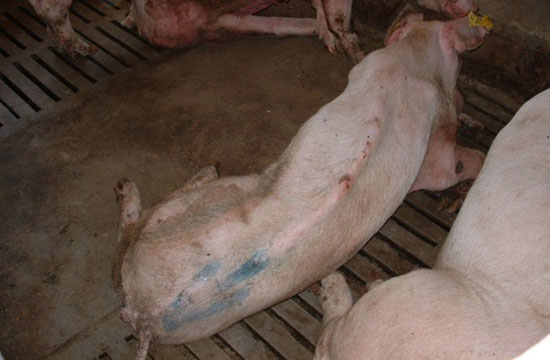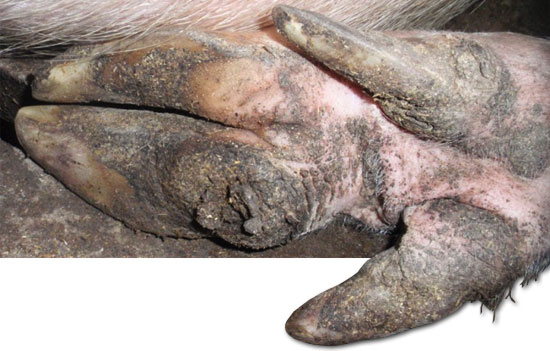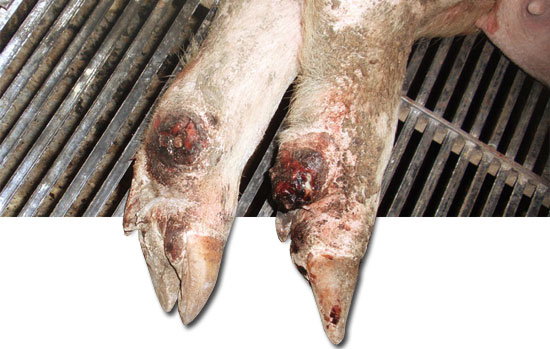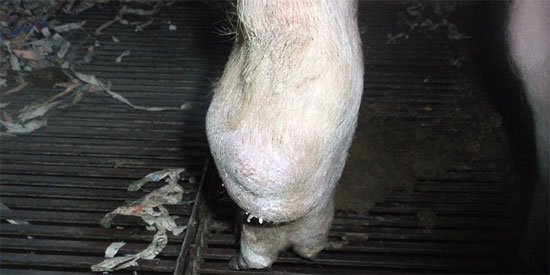In the previous article (Are we underestimating lameness in sows?), we made a first approach to the troubles that the locomotive system problems (normally registered as "lamenesses") imply in the farms. In this second article we are going to analyze the causes of these locomotive system problems and the treatments to avoid them or minimize their effects.
The locomotive system problems can be due to various causes that allow us to distinguish between infectious and non-infectious lamenesses.

Non-infectious lamenesses.-
They have a multifactorial origin, because they can be due to handling defects (fights, rough handling), problems in the installations (faulty slats, slippery floors, etc.), age, genetics (more or less sensitive genetic strains) or nutrition (unbalanced or insufficient diets). The kinds of non-infectious locomotive system problems are:
Osteochondrosis.- They consist of abnormal changes in the cartilage of the joints and in the growth plates of the bones. In this case we see sows that "walk on three feet" or that remain seated like a dog. This normally happens in those gilts that have grown too quickly on slippery floors, or in the case hyperprolific sows after the weaning of their piglets. They do not have a specific treatment and they are not considered as recoverable.
Apophysiolysis.- It is the breaking (fracture) of the ischial tuberosity of the tail bone. The hind limbs remain partially flexed. There is a genetic predisposition, and this problem appears more frequently in some genetic strains; and there is also an important nutritional factor, because adequate levels of phosphorous and vitamin D3 tend to reduce its incidence.

Figure 1.- Sow with apophysiolysis.
Poise problems.- This is one of the main reasons for the culling during the first breeding cycles of the sows. The main cause is a bad selection of the sows that are going to be used as the future breeders. So, in order to avoid these problems we must pay attention to aspects like:
- The position of the fore limbs knees
- The position of the hind limbs
- The size and the position of the fingers
- The position of the fore limbs and hind limbs pasterns

Figure 2.- Rear and longitudinal cuts of a pig's trotter.
Hoof lesions.- They are, strictly speaking, the main cause of the lamenesses of the sows, and they have three main origins:
- Inflammation.- The lesion can be slight (superficial pododermatitis), with a minor lameness; or deep, with a hoof that is very reddened in its rim, with its rim also swollen and painful. In case of a chronic inflammation, there is an excessive and accelerated growth of the hoof (sows with "witch hoofs"). The lesion must be treated when it appears in order to avoid that it becomes chronic.
- Traumatisms.- Due to different causes as, for instance, problems related to the floor or fights. They cause bleeeding in the wall of the hoof or breaks/cracks in it.
- Mechanical factors.- They cause the most typical hoof lesions, and among them we have:
- Overgrowth of the heel.- Due to a chronic excess load that causes the hyperkeratinization of the heel epidermis. The cause is usually genetic (an anomalous formation of the limbs) and it can be treated by cutting off the excessive growth of the hoof.

Figure 3.- Overgrowth of the heel.
- Lesion of the white line, which is the natural union between the heel and the wall, which is more rigid. This lesion can be due to traumatisms, inflammations or mechanical causes, and its treatment includes the clipping of the hoof and the treatment of the infected crack before it worsens.


Figure 4.- Detachement of the auxiliary digit.
- Cracks in the lateral wall.- The cracks can be vertical or oblique, and they cause pain when they are so deep that they reach the corion or when they get infected. So, the crack must be treated as soon as possible, and we must check the compound feed, because they can be due to a nutritional defect.
- Overgrowth of the hoofs or the auxiliary digits.- The hoofs can grow excessively due to a bad floor that does not cause the natural wear down of the hoof (e.g. a plastic floor). These overgrown hoofs can hinder locomotion, and they can also come off due to getting stuck in the slats. So, the hoofs must be clipped.
Infectious lamenesses.-
They can be due to:
Erysipelas.- The arthritic chronic presentation of erysipelas appears when the cutaneous erysipelas have not been treated correctly. The sows show very pronounced lamenesses in one or more limbs that can even show as a paralysis. They can be prevented through vaccination, and the treatment consists of beta-lactam antibiotics (e.g. amoxicillin).
Mycoplasmosis.- Caused by M. hyosynoviae. The affected animal limps all of a sudden and its tarsus is inflammated. The symptoms normally last for 5-10 days. It is prevented medicating the compound feed with macrolides (tiamulin, tylosin).
Brucellosis.- As well as abortions, brucellosis can cause lamenesses, paralysis or a curved back if the bacterium is located in the joints.
Purulent arthritis.- Caused by pyogenic bacteria (streptococci, staphyolococci). They enter the body through wounds and they settle in the joints causing purulent inflammations. They are treated with antibiotics, although the recovery of the animals is difficult if the process is in a medium or advanced stage.

Figure 5.- Purulent inflammation of the tarsus joint.
In these two articles we have checked the general situation with respect to the lamenesses in the farms, as well as their main causes. In order to be able to correct the problems that stem from their appearance, and that many times give place to the premature culling of the animals, it is convenient to make an effort to identify them as soon as possible and to include them in the correct register. Only in this way we will be able to know, in the first place, what kind of lamenesses we have in the farm, how they are having an influence in the production and how we can correct them.




